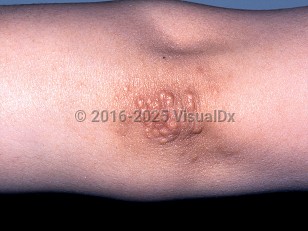Tuberous xanthoma in Adult
Alerts and Notices
Important News & Links
Synopsis

Tuberous xanthomas are nontender, pink-yellow papules or nodules that occur on extensor surfaces, such as the elbows and knees, and on trauma-prone areas, such as the Achilles tendon and buttocks. The presence of tuberous xanthomas typically indicates an underlying disorder of lipid and/or cholesterol metabolism. They may be solitary or grouped.
Tuberous xanthomas are most commonly associated with an underlying primary lipoprotein disorder. Familial dysbetalipoproteinemia (FD) or familial hypercholesterolemia (FH) are autosomal dominant inherited disorders, and 80% of patients with FD have tuberous / tuberoeruptive xanthomas, making these the most common cutaneous presentations of FD. Heterozygous cases of FH occur in 1 of every 500 people worldwide, whereas homozygous cases occur in 1 of every million people worldwide. Many treatment options exist for heterozygotes, while heroic interventions are necessary for homozygotes. Sitosterolemia, an autosomal recessive disorder due to increased intestinal absorption and decreased biliary excretion of plant sterols, can also present with tuberous xanthomas. Normolipemic tuberous xanthomas have occasionally been reported in patients with normal lipid levels and no family history of a lipid disorder.
Secondary causes of tuberous xanthomas may include chronic medical conditions such as hypothyroidism, cholestatic liver disease, and diabetes mellitus or medications such as estrogens or protease inhibitors.
Tuberous xanthomas frequently coexist with eruptive xanthomas, which appear as smaller but similar papules.
Pediatric patient considerations: Children are not affected by tuberous xanthomas unless they have the rare homozygous form of FH.
Tuberous xanthomas are most commonly associated with an underlying primary lipoprotein disorder. Familial dysbetalipoproteinemia (FD) or familial hypercholesterolemia (FH) are autosomal dominant inherited disorders, and 80% of patients with FD have tuberous / tuberoeruptive xanthomas, making these the most common cutaneous presentations of FD. Heterozygous cases of FH occur in 1 of every 500 people worldwide, whereas homozygous cases occur in 1 of every million people worldwide. Many treatment options exist for heterozygotes, while heroic interventions are necessary for homozygotes. Sitosterolemia, an autosomal recessive disorder due to increased intestinal absorption and decreased biliary excretion of plant sterols, can also present with tuberous xanthomas. Normolipemic tuberous xanthomas have occasionally been reported in patients with normal lipid levels and no family history of a lipid disorder.
Secondary causes of tuberous xanthomas may include chronic medical conditions such as hypothyroidism, cholestatic liver disease, and diabetes mellitus or medications such as estrogens or protease inhibitors.
Tuberous xanthomas frequently coexist with eruptive xanthomas, which appear as smaller but similar papules.
Pediatric patient considerations: Children are not affected by tuberous xanthomas unless they have the rare homozygous form of FH.
Codes
ICD10CM:
E78.2 – Mixed hyperlipidemia
SNOMEDCT:
238954002 – Tuberous xanthoma
E78.2 – Mixed hyperlipidemia
SNOMEDCT:
238954002 – Tuberous xanthoma
Look For
Subscription Required
Diagnostic Pearls
Subscription Required
Differential Diagnosis & Pitfalls

To perform a comparison, select diagnoses from the classic differential
Subscription Required
Best Tests
Subscription Required
Management Pearls
Subscription Required
Therapy
Subscription Required
References
Subscription Required
Last Reviewed:10/13/2020
Last Updated:12/09/2020
Last Updated:12/09/2020
Tuberous xanthoma in Adult

